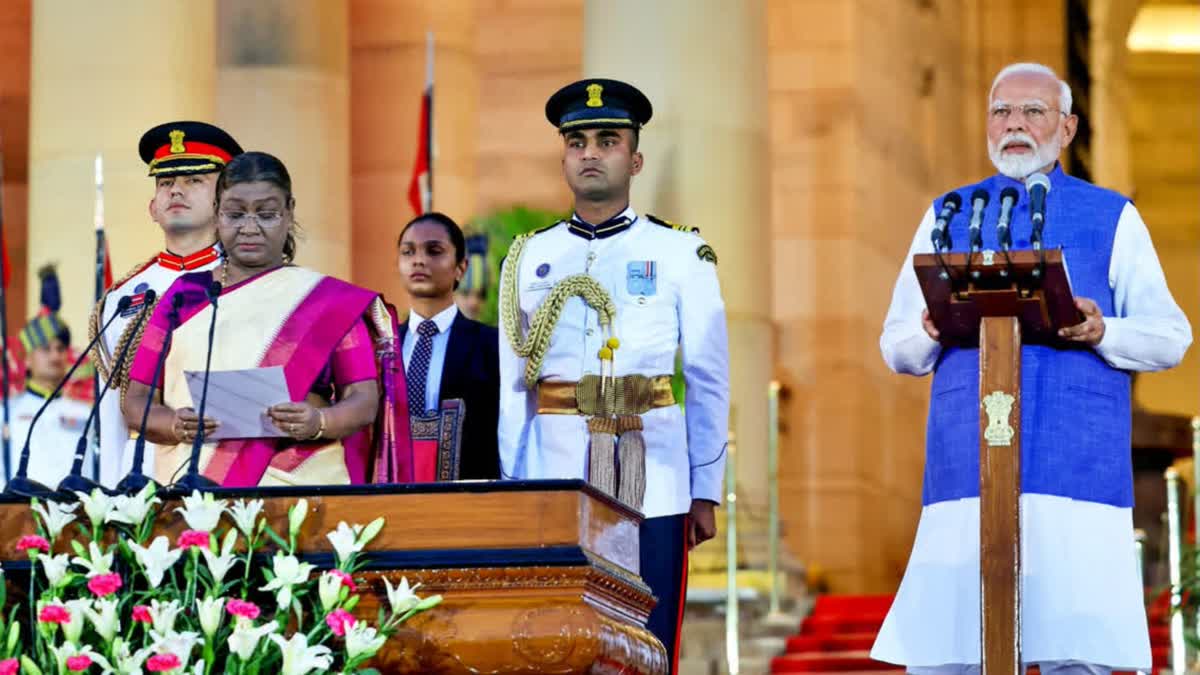On June 4, when the counting began across India at 8 am, the BJP was ahead by bagging the first seat as one of its contestants from a Gujarat Lok Sabha seat was elected unopposed. Thus, the saffron party’s tally began from “one” while it was “zero” for others.
This is the first election the right-wing party faced after it realised one of its long-term programmes of building Ram Temple in Ayodhya.
As the counting progressed, the saffron party’s odometer surged and froze at 240-mark and the Congress at the highest two-digit integer, 99.
The BJP-led National Democratic Alliance(NDA) bagged 293 seats in the 534-seat Lower House, with its major allies Telugu Desam Party and Janata Dal (United) adding 28 seats to the tally. The Shinde-led Shiv Sena which had bagged 5 seats along with a lone seat won by Ajit Pawar-led Nationalist Congress Party, besides five more brought to table by Chirag Paswan’s Lok Jan Shakti Party (Ram Vilas). The election also birthed two kingmakers N Chandrababu Naidu who was in for a double-delight as he was able to wrest Andhra Pradesh from the Jagan-led YSR Congress Party. The other was Nitish Kumar who helped NDA sweep Bihar.
In his reelection bid from Varanasi seat, Modi polled 6,12,970 votes which was 1.5 lakh more than his nearest rival Ajay Rai of Congress, surviving a scare of trailing once during the counting. In 2019, he won the seat by a margin of nearly 4.8 lakh votes.
On that Tuesday (June 4, 2024), an already two-term Prime Minister Narendra Modi, in his victory speech to a cheering crowd at the party headquarters in Delhi, emphasised on uprooting corruption.
He was nearly stepping into his eleventh year and third-term on the trot as India's PM. "The fight against corruption is becoming tougher by the day. Corruption is being shamelessly glorified for political interest. In our third term, the NDA will focus a lot on rooting out corruption of all kinds," Modi said.
The de facto BJP boss was cautious not to tread into the party's decline in the elected House but was seen harping on clean sweeps in Madhya Pradesh, Gujarat, Chhattisgarh, Odisha, Delhi, Himachal Pradesh and Uttarakhand.
"Our Constitution is our guiding light. I want to assure that the Centre will work with all states, irrespective of the party in power there, to work towards our resolve to make India a developed country," the Prime Minister said.
The stage from where he delivered his address bore a note– Thank You Bharat– in different languages, including Urdu.
Despite its poor show in the south, the saffron party opened its account in Kerala for the first time since its electoral plunge.
In Gujarat from where PM served as the Chief Minister before becoming the Prime Minister, the Congress managed to open its tally for the first time since 2014.
For Modi, it was a record-equalling historic third term as Prime Minister rivalling the country’s first prime minister Jawaharlal Nehru who had served three consecutive terms.
Also, it is the first time that the septuagenarian who is dependent on allies to run the government since his plunge into electoral politics. He was later elected as the leader of the NDA Parliamentary Party as necessitated by the laws to become the PM. Unlike in the previous decade, the BJP-led coalition has allies that matter to the government as they depend on their votes to either adopt or reject every motion that is put to vote in the Lower House. The change was visible when leaders from the alliance partners were seated on the dais along with Modi at the NDA Parliamentary Party meeting which was convened before Modi could officially be invited by the President to form the government. The election results also heralded the return of a coalition government at the centre in its true form with the NDA allies being part of the Modi's Union Cabinet.
In the run-up to the election, Modi’s poll stops during the Lok Sabha election campaign culminated with a rally he addressed in Punjab's Hoshiarpur on May 30. He participated in at least 206 public programmes since the Election Commission (EC) announced the poll schedule on March 16. He outdid himself from his previous 145 public engagements during the 2019 Lok Sabha election. He was interviewed by the media for 80 times in the 76 day campaign period. On an average he was featured by more than one news outlet everyday.
The results showed most of the pollsters having got it all wrong. Their seat projections were crunched using their exit poll data for the Lok Sabha 2024 elections. While they predicted a complete rout for the opposition INDIA bloc, its tally rose to 238 seats when the votes were counted. The opposition's good show in Rajasthan, Maharashtra, and Uttar Pradesh drove up the numbers. The regional partners brought more to the alliance’s kitty from Tamil Nadu, Kerala and West Bengal. The Modi-led NDA performed below par as regards to the exit polls projections. Most of the exit polls gave the ruling-NDA over 350 seats.
The results marked the return of regular election planks that concern ordinary Indians and their daily life and have a direct bearing on their bread and butter. The INDIA bloc managed to put the message across to its voters especially in the Hindi heartland. Its message is that of unemployment and price rise. According to the recent Household Consumption Expenditure Survey (HCES), the average Monthly Per Capita Consumption Expenditure (MPCE) rose by 33.5 per cent and 40.42 per cent, to ₹3,510 and ₹2,008 in Indian households since 2011-12. The former is for urban households, the latter for rural.
As for Rahul Gandhi, it was a revival of the grand old party. Its allies brought more than 139 seats to the opposition’s overall tally. In his personal contest, he won both Rae Bareli and Wayanad.
Read More
Nimisha Priya Case: Centre Allows Fund Transfer Through Embassy For Kerala Nurse's Release
